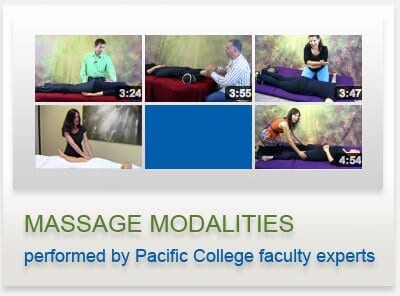With so many massage types or “modalities” out there, it can be overwhelming trying to figure out which type of massage is right for you. Each massage modality is unique and uses different techniques to best address the needs of the patient. One common trait you will find amongst the Asian modalities is that they are performed with the patient’s clothes on, unlike Western “Swedish” massages, which use oils and are done without clothing. Find out more about the different styles below and click on the links to watch short video demos of each, performed by Pacific College faculty experts.
Swedish Massage: A Relaxing and Popular Choice
Swedish Massage: This is the most commonly practiced form of Western massage. If you’re going to a spa, they will offer Swedish massage. It uses a variety of techniques to relax muscles by applying light, moderate, or deep pressure to muscles and bones, and increases the range of motion at joints and promotes blood circulation to the heart. The main purpose of Swedish massage is to increase the oxygen flow in the blood and release toxins from the muscles. If you’re looking for a relaxing massage to help you unwind, you can’t go wrong with Swedish.
Shiatsu: A Japanese Technique Focusing on Pressure Points
Shiatsu: (Japanese from ‘shi’, meaning finger, and ‘atsu’, meaning pressure) is a traditional hands-on therapy originating in Japan. There are two main Shiatsu schools: one based on Western anatomical and physiological theory and the other based on traditional Chinese medicine (TCM). Shiatsu is an evolving form, and its various styles incorporate (to differing degrees) aspects of Japanese massage traditions, Chinese Medicine practice, and Western anatomy and physiology. This modality is usually performed on the floor and uses pressure points, applied through the fingers instead of the entire palm, so pressure may feel more firm. Shiatsu has been used to treat a wide array of conditions including headaches, insomnia, injury recovery, and more.
Thai Massage: Combining Stretching with Pressure Point Techniques
Thai Massage: This style of massage involves stretching and pressure point techniques along theoretical energy channels. This form of bodywork is usually performed on the floor, and the client wears comfortable clothes that allow for movement. It’s known in Thailand as “nuat phaen boran”, literally “the ancient-manner massage”. Thai massage uses a lot of deep stretching and yoga-like poses, so it’s often recommended for people involved in sports, dance, etc. whose muscles need some good stretching.
Tui Na: A Chinese Manipulative Therapy
Tui Na: This is a form of Chinese manipulative therapy often used in conjunction with acupuncture, moxibustion, fire cupping, Chinese herbalism, Tai Chi, and Qi Gong. Tui Na is a hands-on body treatment that uses Chinese Taoist and martial art principles to bring the body to balance. The practitioner may brush, knead, roll/ press and rub the areas between each of the joints (known as the eight gates) to open the body’s defensive (wei) qi and get the energy moving in both the meridians and the muscles. Tui Na works well for someone with an illness, someone with lower back pain, or just regular everyday built up tension.
Specialized Massage Techniques: Reflexology and its Effects
Reflexology: involves the physical act of applying pressure to the feet and hands with specific thumb, finger, and hand techniques without the use of oil or lotion. It is based on a system of zones and reflex areas that are thought to reflect as a map on the feet and hands, with the premise that it can affect all areas of the body through reflex responses. If you’re looking for a full-body massage, this is not it, but reflexology is more than a foot massage, it improves circulation throughout the body, and is a popular choice of complementary therapy amongst cancer patients, according to a study in the American Cancer Society journal.
All of these techniques have beneficial qualities to offer, so if you’re in doubt as to which type of massage is right for you, there’s no harm in trying them all and seeing for yourself which one fits you best. You can find all of these styles, at discounted and affordable rates, at the Pacific College of Oriental Medicine Clinic.
Are you interested in becoming a certified massage therapist?
Visit the links below to explore our massage therapy programs at a campus near you:
Featured Posts:

